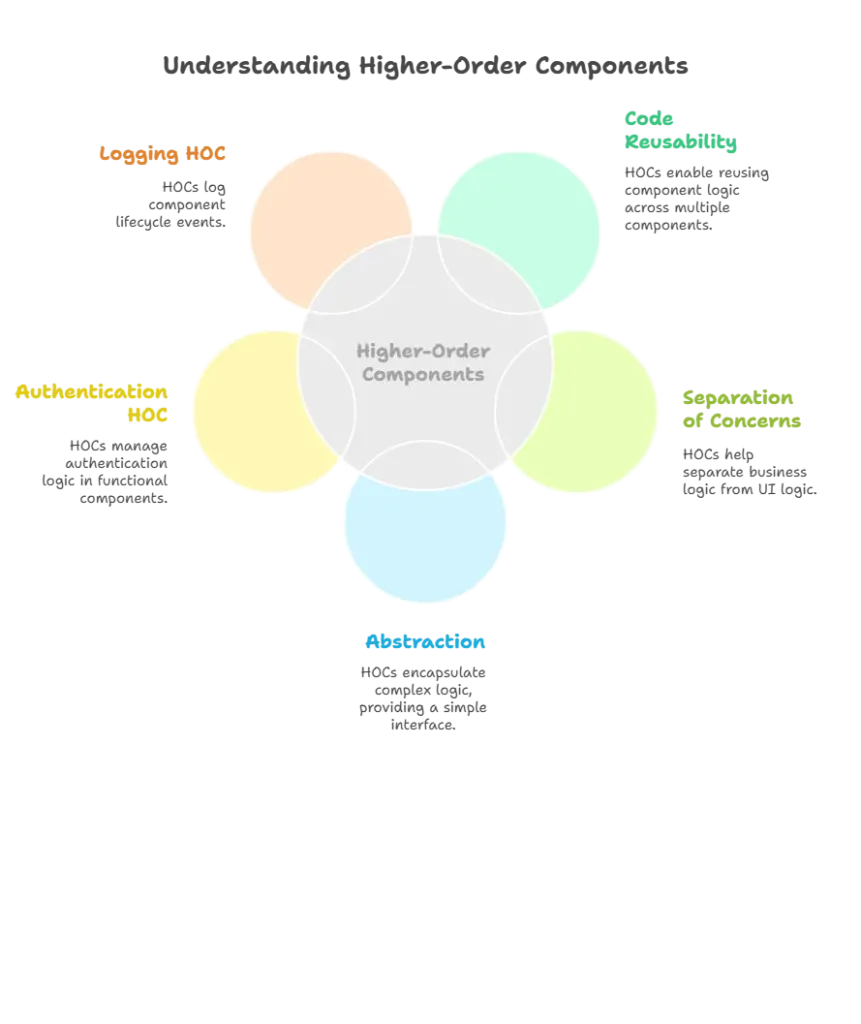Higher Order Components
Higher-Order Components (HOCs) can be effectively used with functional components in React. This chapter will cover everything you need to know about using HOCs with functional components, including detailed examples and explanations.
What is a Higher-Order Component?
A Higher-Order Component (HOC) is a function that takes a component and returns a new component. HOCs allow you to reuse logic, separate concerns, and create higher levels of abstraction.
Why Use Higher-Order Components?
- Code Reusability: HOCs help in reusing component logic across multiple components.
- Separation of Concerns: They help in separating business logic from UI logic.
- Abstraction: HOCs can encapsulate complex logic and provide a simple interface.
Basic Concepts of Higher-Order Components
Let’s start with the basics of HOCs and how to create one.
Creating a Simple HOC
Here’s how you can create and use an HOC with a functional component:
import React from 'react';
// HOC definition
const withExtraInfo = (WrappedComponent) => {
return (props) => {
return (
<div>
<p>Extra Information</p>
<WrappedComponent {...props} />
</div>
);
};
};
// Functional component
const BasicComponent = (props) => {
return <div>{props.message}</div>;
};
// Enhanced component
const EnhancedComponent = withExtraInfo(BasicComponent);
// App component
const App = () => {
return <EnhancedComponent message="Hello, World!" />;
};
export default App;
Explanation
- withExtraInfo: This is the HOC function that takes
WrappedComponentas an argument and returns a new functional component that wraps theWrappedComponentwith additional content. - BasicComponent: A simple functional component that displays a message.
- EnhancedComponent: The result of applying the HOC to
BasicComponent. - App: The main application component that renders
EnhancedComponent.
Output
When you run this application, you will see “Extra Information” followed by “Hello, World!”.
Advanced Concepts of Higher-Order Components
Passing Props to HOCs
You can pass additional props to the wrapped component using HOCs with functional components.
import React from 'react';
// HOC definition
const withUser = (WrappedComponent) => {
return (props) => {
const user = { name: 'John Doe', age: 30 };
return <WrappedComponent user={user} {...props} />;
};
};
// Functional component
const UserComponent = (props) => {
return (
<div>
<p>Name: {props.user.name}</p>
<p>Age: {props.user.age}</p>
</div>
);
};
// Enhanced component
const EnhancedUserComponent = withUser(UserComponent);
// App component
const App = () => {
return <EnhancedUserComponent />;
};
export default App;
Explanation
- withUser: This HOC adds a
userprop to the wrapped component. - UserComponent: A functional component that displays user information.
- EnhancedUserComponent: The result of applying the
withUserHOC toUserComponent.
Output
When you run this application, you will see “Name: John Doe” and “Age: 30”.
Accessing Wrapped Component’s Instance
In functional components, you can use the useRef hook to access the wrapped component’s instance. However, functional components themselves cannot have instances like class components, so this is usually unnecessary unless working with class components.
Common Use Cases of Higher-Order Components
Authentication HOC
You can use HOCs to manage authentication logic in functional components.
import React from 'react';
import { Redirect } from 'react-router-dom';
// HOC definition
const withAuth = (WrappedComponent) => {
return (props) => {
const isAuthenticated = true; // Replace with actual authentication logic
if (!isAuthenticated) {
return <Redirect to="/login" />;
}
return <WrappedComponent {...props} />;
};
};
// Functional component
const Dashboard = () => {
return <div>Welcome to the Dashboard</div>;
};
// Enhanced component
const ProtectedDashboard = withAuth(Dashboard);
// App component
const App = () => {
return <ProtectedDashboard />;
};
export default App;
Explanation
- withAuth: This HOC checks if the user is authenticated and either renders the wrapped component or redirects to the login page.
- Dashboard: A functional component that displays a welcome message.
- ProtectedDashboard: The result of applying the
withAuthHOC toDashboard.
Output
When you run this application, you will see “Welcome to the Dashboard”. If isAuthenticated is set to false, you will be redirected to the login page.
Logging HOC
Another common use case is logging component lifecycle events. While functional components do not have lifecycle methods, you can use hooks to achieve similar functionality.
import React, { useEffect } from 'react';
// HOC definition
const withLogger = (WrappedComponent) => {
return (props) => {
useEffect(() => {
console.log(`${WrappedComponent.name} mounted`);
return () => {
console.log(`${WrappedComponent.name} will unmount`);
};
}, []);
return <WrappedComponent {...props} />;
};
};
// Functional component
const SampleComponent = () => {
return <div>Sample Component</div>;
};
// Enhanced component
const LoggedComponent = withLogger(SampleComponent);
// App component
const App = () => {
return <LoggedComponent />;
};
export default App;
Explanation
- withLogger: This HOC uses the
useEffecthook to log messages when the wrapped component mounts and unmounts. - SampleComponent: A functional component to be wrapped.
- LoggedComponent: The result of applying the
withLoggerHOC toSampleComponent.
Output
When you run this application, you will see “SampleComponent mounted” in the console. When the component unmounts, you will see “SampleComponent will unmount”.
Pitfalls and Best Practices
Avoid Overusing HOCs
While HOCs are powerful, overusing them can lead to complex and hard-to-maintain code. Use HOCs judiciously and consider alternatives like hooks or render props when appropriate.
Maintain Clear Prop Management
Ensure that props are managed and passed correctly between HOCs and wrapped components to avoid unexpected behavior.
Name Wrapping Components
Name your HOCs and wrapped components clearly to improve readability and debugging.
const withExtraInfo = (WrappedComponent) => {
return (props) => {
return <WrappedComponent {...props} />;
};
};

Higher-Order Components are a powerful pattern in React that allow for the reuse of component logic, even with functional components. By understanding the concepts and use cases discussed in this chapter, you can effectively implement HOCs in your React applications, ensuring code reusability and better separation of concerns. Remember to use HOCs judiciously and maintain clear and readable code. Happy coding !❤️
